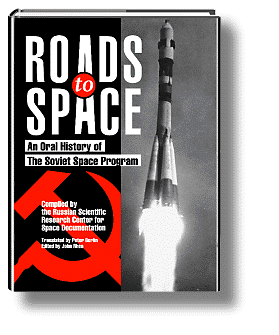Development of the Luna sweeping-carrier
ranging
system
I stumbled upon an
excellent
description of the sweeping-frequency
ranging system used by many Soviet deep-space missions when reading
Roads
to Space (1, see dust cover on the
right).
In one of the oral histroical accounts Leonid Ivanovich Gusev, the
Director
General and Chief Designer of the Russian Scientific Institute of Space
Instrument Engineering (RNIIKP), formerly known as NII-885:
 "....Our
main preoccupation was the radio link margin on which the accuracy of
trajectory
measurements as well the data transmission rate and volume depended.
There
were several ways of improving the link margins, for example by
increasing
the transmitter power, or the receiver sensitivity. Alternatively, we
could
have moved to much higher frequencies. But these straightforward
solutions
were time-consuming and very expensive. A better way forward was
proposed
by Y. Y Boguslavskiy, who had invented a method of determining the
slant
range to a spacecraft by uplinking a carrier with a rapidly changing
changing
carrier frequency. The uplinked carrier was turned around by an onboard
transponder and retransmitted to the ground, where he slant range was
determined
by using differential frequency analysis. Boguslavskiy's method used
very
narrow bandwidths which could be tracked by phase/frequency converters.
Since the background noise level is inversely proportional to the
bandwidth,
a very good signal-to-noise ratio was achieved which favourably
influenced
the link margin.
"....Our
main preoccupation was the radio link margin on which the accuracy of
trajectory
measurements as well the data transmission rate and volume depended.
There
were several ways of improving the link margins, for example by
increasing
the transmitter power, or the receiver sensitivity. Alternatively, we
could
have moved to much higher frequencies. But these straightforward
solutions
were time-consuming and very expensive. A better way forward was
proposed
by Y. Y Boguslavskiy, who had invented a method of determining the
slant
range to a spacecraft by uplinking a carrier with a rapidly changing
changing
carrier frequency. The uplinked carrier was turned around by an onboard
transponder and retransmitted to the ground, where he slant range was
determined
by using differential frequency analysis. Boguslavskiy's method used
very
narrow bandwidths which could be tracked by phase/frequency converters.
Since the background noise level is inversely proportional to the
bandwidth,
a very good signal-to-noise ratio was achieved which favourably
influenced
the link margin.
I had the
opportunity
to develop the instrument that generated those sweeping
carrier signals. It was a custom-made computer which controlled
the sweep using frequency synthesizers, determined the phase difference
between the signals in the uplink and downlink, and solved the
equations
that yielded the speed and distance of the spacecraft. As head of our
laboratory
I not only developed the equipment but also supervised its manufacture
and subsequent installation at the TT&C stations in Simeiz and
Simferopol.
The computer supported spacecraft flights to the Moon, Mars, and Venus.
The lunar mission included taking pictures of the Moon's surface,
steering
the Lunokhod rover and bringing back soil samples to Earth. ......."
L.I
Gusev, in "Roads to Space, An oral history of the Soviet Space
program",
Aviation Week Group, 1995, p.426

 Back
to "The radio systems of the early Luna probes"
Back
to "The radio systems of the early Luna probes"
 "....Our
main preoccupation was the radio link margin on which the accuracy of
trajectory
measurements as well the data transmission rate and volume depended.
There
were several ways of improving the link margins, for example by
increasing
the transmitter power, or the receiver sensitivity. Alternatively, we
could
have moved to much higher frequencies. But these straightforward
solutions
were time-consuming and very expensive. A better way forward was
proposed
by Y. Y Boguslavskiy, who had invented a method of determining the
slant
range to a spacecraft by uplinking a carrier with a rapidly changing
changing
carrier frequency. The uplinked carrier was turned around by an onboard
transponder and retransmitted to the ground, where he slant range was
determined
by using differential frequency analysis. Boguslavskiy's method used
very
narrow bandwidths which could be tracked by phase/frequency converters.
Since the background noise level is inversely proportional to the
bandwidth,
a very good signal-to-noise ratio was achieved which favourably
influenced
the link margin.
"....Our
main preoccupation was the radio link margin on which the accuracy of
trajectory
measurements as well the data transmission rate and volume depended.
There
were several ways of improving the link margins, for example by
increasing
the transmitter power, or the receiver sensitivity. Alternatively, we
could
have moved to much higher frequencies. But these straightforward
solutions
were time-consuming and very expensive. A better way forward was
proposed
by Y. Y Boguslavskiy, who had invented a method of determining the
slant
range to a spacecraft by uplinking a carrier with a rapidly changing
changing
carrier frequency. The uplinked carrier was turned around by an onboard
transponder and retransmitted to the ground, where he slant range was
determined
by using differential frequency analysis. Boguslavskiy's method used
very
narrow bandwidths which could be tracked by phase/frequency converters.
Since the background noise level is inversely proportional to the
bandwidth,
a very good signal-to-noise ratio was achieved which favourably
influenced
the link margin.